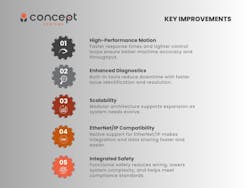Why Now Is the Time to Plan Servo Drive Upgrades
Why this article is worth reading:
- As servo drive technology evolves, manufacturers face inevitable product lifecycle changes that require proactive evaluation of aging motion control systems before replacement parts become scarce and downtime risks escalate.
- Newer servo drive systems offer enhanced performance, improved diagnostics, integrated safety features and better compatibility with contemporary network architectures, supporting both operational efficiency and digital transformation initiatives.
- Planning modernization efforts ahead of system failures allows manufacturers to perform code updates offline, test hardware beforehand and align upgrades with broader operational goals rather than making reactive decisions under emergency pressure.
Servo drive technology continues to evolve, and with this progress comes inevitable product lifecycle changes. For example, at the end of 2025, Rockwell Automation’s Kinetix 6000 servo drive model series will be officially discontinued, following several years of phased discontinuation across the product line.
This shift raises important questions for plant managers, engineers and maintenance teams: How long can we rely on an aging motion control system? What are the risks of waiting to upgrade? And how can we approach the upgrade process in a way that minimizes disruption to production?
For many operations, the first signs of challenge come in the form of replacement parts. As discontinued components become harder to source, downtime risks increase. Even refurbished parts — sometimes the only option — carry uncertainty in both availability and reliability. Unplanned downtime tied to a failed servo drive can translate to significant production losses, especially in high-throughput environments.
The modernization opportunity and challenge
But the challenge of obsolescence also brings an opportunity. Newer servo drive platforms, such as the Kinetix 5700, introduce improvements not just in availability but also in performance, scalability and integration. These systems offer higher performance motion control, improved diagnostics and support for integrated safety features. They also align more seamlessly with modern network architectures like EtherNet/IP, simplifying overall control system design.
These benefits can help manufacturers reduce downtime, improve system reliability and better align with digital transformation initiatives.
The upgrade process, however, is not a direct hardware swap. Transitioning from older platforms requires evaluation of existing PLC capacity, network infrastructure and software compatibility. Manufacturers should expect that at least some PLC programming changes will be necessary due to differences in data structures and communication protocols.
Planning ahead for such changes allows teams to address these technical considerations on their own schedule, rather than under the pressure of a failure-driven replacement.
A key advantage of proactive planning here is that necessary PLC code updates can often be performed offline while the system remains in production. The PLC code can also be tested with the physical hardware prior to installation onsite, although the level of testing that can occur offsite depends on the complexity of the system and how much can be replicated.
While much of the existing code can often be reused, certain pieces inevitably need to be modified due to different tag data types and control structures. By testing and validating code ahead of installation, teams can significantly reduce the risk of unexpected downtime during the switchover.
Beyond mitigating downtime risk, proactive planning enables manufacturers to align an upgrade with broader operational goals. Whether that involves expanding capacity, improving diagnostics or positioning for future automation initiatives, the choice to modernize motion control systems can support long-term productivity and flexibility.
For plants still operating legacy servo drive systems, now is an opportune time to begin evaluating upgrade paths. By understanding the technical requirements and potential benefits early, manufacturers can make informed decisions that protect both their uptime and their ability to adapt in the years ahead.
Kelly Collins is principal engineer at Concept Systems, certified members of the Control System Integrators Association (CSIA). For more information about Concept Systems, visit its profile on the Industrial Automation Exchange.
More automation tech upgrade coverage from Automation World:
About the Author

Leaders relevant to this article:

